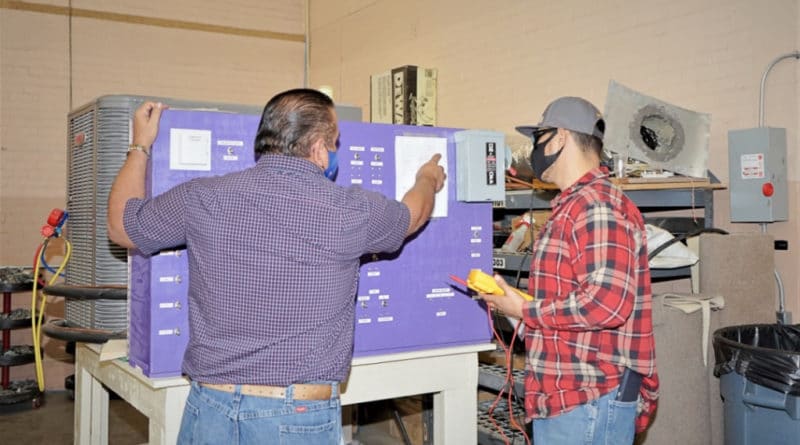HVAC-R, Building Trades Program
For anyone looking to find work in a trade, the Gila Pueblo Campus of Eastern Arizona College offers a couple of good options with its HVAC-R and building trades programs. In the HVAC-R (Heating, Ventilation and Air Conditioning and Refrigeration) course, students learn not only how to repair heaters and air conditioners but also to install them. Students get to practice diagnosing problems on a simulator that reproduces residential HVAC units. “With this, we can fail a component in this system by flipping a switch,” said HVAC/building trades instructor Gabe Eylicio. “As a student, you come in with your voltage meter and start testing what the issue could be. So, when you get out in the field and have the same issue, you can have a basic idea of what’s going on. This really gives you a jump-start on the technical side of air conditioning.
“We’ll take a window air conditioning unit, tear it apart, remove the refrigerant and then build a new unit. It gives students a very good background.”
As well as hands-on work, the course offers printed study materials and instructional videos to help students learn the trade. HVAC-R students also learn about types and categories of refrigerants used in air conditioners and can become certified in four categories – basic, low-pressure refrigerant, medium-pressure refrigerant and high-pressure refrigerant – by passing a series of Environmental Protection Agency tests.
The course takes three semesters to finish, usually starting in the fall semester and ending in the summer. “There’s a lot of demand for skilled workers in the HVAC-R world,” said Eylicio. Not only can the course help students go on to careers in HVAC-R, it can also help anyone who just wants to learn how to repair their own air conditioners. “That’s the kind of education you’ll get through this program.” “We teach a broad aspect of construction in the building trades classes,” said Eylicio. Students in the one-semester basic building trades class get to learn repairs, resealing and weatherization, build sheds and learn construction math, including how to read tape measures. “The construction math part is huge in the field because now you can estimate the cost of materials, time, labor – all of that,” said Eylicio. Building trades students can also learn cabinetry if they like.
The course also teaches students ways to write an effective resume for the construction field and apply for jobs. “We give students the basics of everything. Our books are in-depth, and explain a lot. They go from what size nails to use to what type of wood you will need. So you’ll be able to identify the issues when you get to a job site,” said Eylicio. “As you’re working in the field, you can gather more information.” Those who would like to learn more in the classroom can go on to Building Trades II, also a semester long, which offers more in-depth instruction. In this more advanced class, students learn about roof pitches, sheet rock and examples of custom work.
Students have also gotten to build sheds as part of the classes; basic work sheds in the basic class and more advanced ones in Building Trades II, which taught basic wiring, insulation, sheet rock work and even tile flooring. “The industry is looking for employees and nobody’s really applying. If they are, they don’t have the basic skills to even hold that position. We’re trying to fill that void in the industry with our building trades classes,” said Eylicio.
Enroll Today in EAC Spring Classes: Classes begin Jan. 19 with social distancing in place. Financial aid is available for students who qualify. Register by calling the EAC Gila Pueblo Campus Administration Office at 928-425-8481, or online at www.eac.edu.

